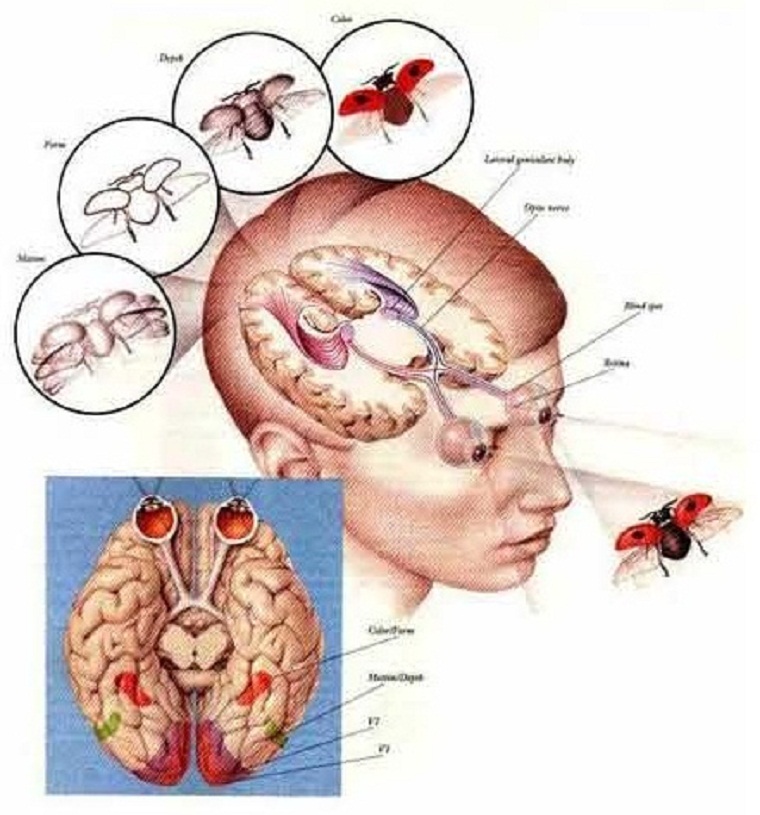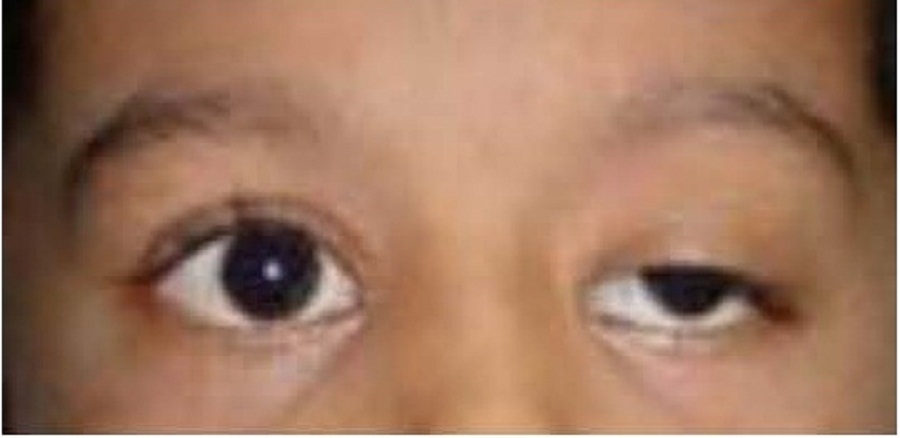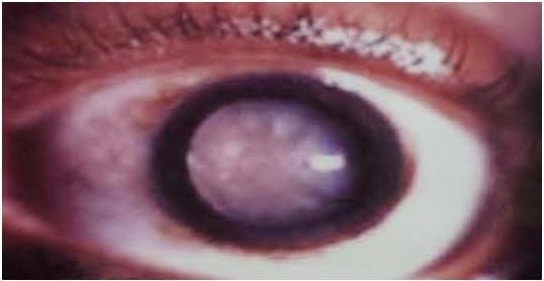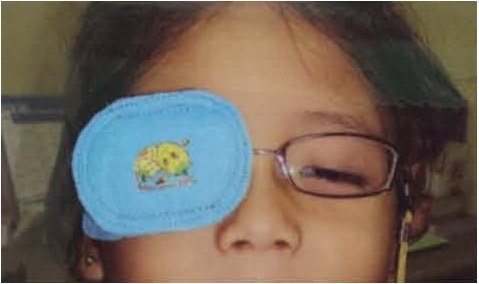What is amblyopia or ‘Lazy Eye?‘
Amblyopia or lazy eye is an eye condition that refers to blur vision that is not correctable by glasses, contact lenses or eye surgery. The eyes look normal and no eye diseases detected. This condition commonly occur in one eye and rarely in both eyes

Blur view

Normal view
Figure 1: Amblyopia occur when one eye has blur vision and normal vision on the other eye. The brain will naturally ‘shut off’ the blur vision eye and see with normal vision eye.
Is the amblyopic eye blind?
No. The amblyopic eye is never blind in the sense of being entirely without vision, but has very poor vision and can be categorized as low vision or blind eye by World Health Organization (WHO) definition.
(WHO definition of blind is visual acuity of less than 3/60 and low vision is defined as visual acuity of less than 6/18 but equal or better than 3/60 in better eye with best correction.)
How do you get amblyopia?
Amblyopia occurs when there is an obstruction during transmission of visual information from the eye to the brain during ‘critical period’ or early stage betweenbirths to 6 year old. This obstruction reduces stimulation to parts of the brain concerned with visual processing to function properly.
As a result brain can’t translate the object information. Causes the eye to see blurry image. The brain learns to ‘ignore’ the eye with the blurred vision and sees with the good eye only. Consequently the unused eye will develop amblyopia.

Figure 2 : Diagram shows the eye and the brain
What causes amblyopia?
Amblyopia usually results from the failure to use both eyes together.
Three main causes of amblyopia:
- Constant unilateral squint (crossed-eyes) (see squint)
In the event of squint, one eye would be looking straight and the other constantly deviate away either turning in, out, up or down. Each eye sees different objects and causing the eyes to see two objects simultaneously (double vision).
Subsequently, patient may experience giddiness, headache or nausea. In this case, the brain will suppress or ‘ignore’ the turning eye to avoid confusion or double vision. As a result the vision will be blurred and amblyopia will develop in the turning eye.
- Refractive amblyopia – anisometropia (see Short-sighted, farsighted, astigmatism)
Anisometropia is a condition when there is a large or unequal amount of eyeglasses power. A condition which one eye is more shortsighted (hypermetropia), farsighted (myope) or astigmatism than the other eye.
The vision in this eye is blurrer than the other eye. Naturally, the brain will slowly “turn off” this eye and see with better eye. The unused eye slowly will develop amblyopia if left untreated.
- Physical obstruction of vision
This is an abnormality of the eye structure, such as dropping of eyelid (ptosis), scar on the cornea (due to trauma or congenital) and cataract (cloudiness of the lens). All these obstructions will disrupt the visual information from being transmitted to the brain causing the eye having blurred vision. The brain will ignore this eye and sees with good eye. The unused eye will slowly develop amblyopia if left untreated.

Left eye Ptosis (drooping eye lid)

Cataract (cloudiness of the lens)
Figure 3: Abnormality at the eyelid (ptosis) and cataract
Who is likely to develop amblyopia?
Children who have the above problems (refractive error, squint and physical obstruction of vision) would likely develop amblyopia.
Amblyopia is a common problem in children. It is one of the main causes for vision loss in children.
What are the symptoms of amblyopia?
Children who have amblyopia rarely complain of blurred vision. This is because the child can still see with the better eye.
Similarly, if both eyes are amblyope, children rarely complain because they think this is normal in everyone.
Who can detect and treat ‘Amblyopia’?
Optometrists and Ophthalmologists (Eye Specialist) can detect ‘Lazy Eye’ through a comprehensive eye examination at government hospitals and private practice.
Where is the treatment available?
Treatment is available at Eye Clinic, Government Hospitals and from private Optometrists who offer amblyopia therapy.
When is the right time to do eye screening for ‘Amblyopia’?
To avoid delays in detection and treatment, children (infants to teens) should undergo an eye examination including vision test once a year.
The best time for amblyopia detection is before seven years old. Early detection will offer effective treatment and the best chance for cure.
What is the treatment for ‘amblyopia?
Treatments include one or a combination of the following methods:
1. Treating the causes of ‘Lazy Eye’ in advance:
• Correct the squint
• Treat or correct eye structure abnormalities through surgery such as: cataract, ptosis, corneal scar.
• Treat refractive errors with glasses or contact lenses.
2. Visual therapy
Visual therapy is done by patching the good eye during awaking hours. Patching the good eye will enable and forced the amblyopic eye to see by doing near work exercise such as painting, drawing, reading and tracing.
The optometrist will recommend patching hours and near work exercise, depending on the patients’ age, type and severity of amblyopia .This short training can also use other tools such as Visual physiological Recovery Apparatus (VPRA) and amblyopia Computer Software Program.

Figure 4 : Eye patch

Figure 5: Activities during amblyopia therapy
What are the goals of amblyopia treatment?
The goal is to get the best possible vision in each eye. Not all cases can be improved to normal vision, most can obtain substantial improvement vision. The improvement of vision depends on patient’s age, severity of amblyopia and compliance to the therapy.
What happens when the patient defaults therapy?
Vision will be blurred and it could be permanent.
Early treatment is very important to determine a successful rate of recovery. Treatments are most effective when performed before the children reach 9 years old.
Career opportunities are limited for those who have amblyopia. Certain jobs require employees to have good vision in both eyes such as: pilots, soldiers and firemen.
References
1. Millodot, M., 2004. Dictionary of Optometry and Visual Sciene. Ed. ke-4. Oxford: Reed. Educational and Profesional publishing.
2. American Optometric Association. Optometric clinical practice guideline: care of the patient with ambliopia, American Optometry Association 1994.
3. Pediatric Eye Disease Investigator Group (PEDIG). A randomized Pilot Study of Near Activities Versus Non-near activities during patching therapy for ambliopia. Journal of American Association for Pediatric Ophthalmology & Strabismus 2005;9:129-36.
4. Noorden GK, Campos E. Binocular Vision and Ocular Motility. 6th ed. St. Louis: Mosby, 2002.
5. American Association for Pediatric Ophthalmology and Strabismus Amblyopia. www.aapos.org/terms/conditions/21. Assessed Jun 2013.
6. Gambar 2. www.khilafatworld.com
7. Gambar 3. www.sandipjain.com
| Last Reviewed | : | 18 Jun 2014 |
| Writer | : | Pn. Nor Aini Hanafi |







